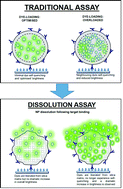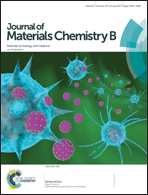‘Overloading’ fluorescent silica nanoparticles with dyes to improve biosensor performance†
Abstract
Using dye-doped silica nanoparticles (DSNP) as reporter probes, we describe a simple method of enhancing fluorescent signal and the extension of the detectable target concentration range in a proof-of-concept ‘dissolution immunoassay’. DSNPs were intentionally ‘overloaded’ with 3% (w/w) FITC such that the high concentration of dye inside the NP core induced self-quenching. Despite exhibiting reduced brightness, the ‘overloaded’ DSNPs were then functionalized with anti-human IgG and were subsequently used to detect human IgG, a model biomarker, in whole serum. Following human IgG recognition, the ‘overloaded’ DSNPs were dissolved using pH 10.6, 0.1 M sodium carbonate–bicarbonate buffer. The large quantity of FITC inside the NP core was consequently released into solution, thus liberating the dyes from self-quenching, and led to a large increase in fluorescein emission intensity. This effect was further enhanced when coupled with FITC's increased quantum yield in basic conditions. The overall result was a 12-fold enhancement in fluorescent signal intensity and an 11-fold improvement in signal-to-noise ratio after a dissolution time of 60 min. In the assay setup presented, the net signal-to-noise ratio for ‘overloaded’ DSNPs was up to 9 times greater following degradation compared to traditionally used 1% (w/w) ‘optimal’ dye-loaded DSNPs. Crucially, this ‘dissolution assay’ strategy using ‘overloaded’ DSNPs could confidently detect human IgG at a 10-fold lower concentration than traditionally used ‘optimal’ DSNPs.



 Please wait while we load your content...
Please wait while we load your content...